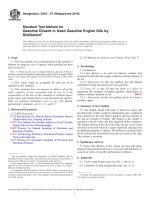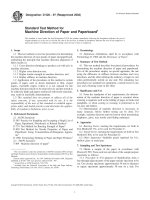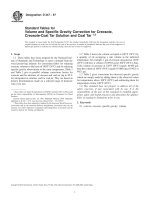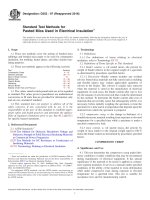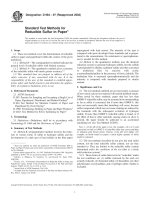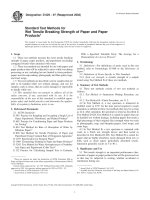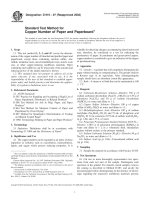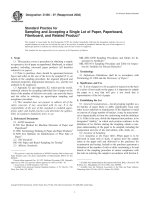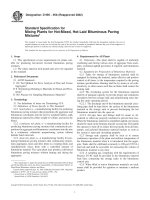Astm d 829 97 (2002)
Bạn đang xem bản rút gọn của tài liệu. Xem và tải ngay bản đầy đủ của tài liệu tại đây (64.82 KB, 5 trang )
Designation: D 829 – 97 (Reapproved 2002)
An American National Standard
Standard Test Methods for
Wet Tensile Breaking Strength of Paper and Paper
Products1
This standard is issued under the fixed designation D 829; the number immediately following the designation indicates the year of
original adoption or, in the case of revision, the year of last revision. A number in parentheses indicates the year of last reapproval. A
superscript epsilon (e) indicates an editorial change since the last revision or reapproval.
With a Specified Tolerable Error, The Average for a
Characteristic of a Lot or Process4
1. Scope
1.1 These test methods measure the (wet) tensile breaking
strength of paper, paper products, and paperboard (excluding
corrugated board) when saturated with water.
1.2 These test methods are intended for use with papers and
paper products that will be subjected to stress while wet during
processing or use, including but not limited to tissue products,
papers used in map-making, photography and blue prints, bags,
and food wraps.
1.3 Two test methods are described; one for samples that are
able to be handled while wet without damage, and one for
samples, such as tissue, that are easily damaged or impossible
to handle while wet.
1.4 This standard does not purport to address all of the
safety concerns, if any, associated with its use. It is the
responsibility of the user of this standard to establish appropriate safety and health practices and determine the applicability of regulatory limitations prior to use.
3. Terminology
3.1 Definitions—For definitions of terms used in this test
method, refer to Terminology D 1968 or the Dictionary of
Paper.5
3.2 Definitions of Terms Specific to This Standard:
3.2.1 finch wet strength, n—tensile strength of a sample
tested using Test Method B of these test methods.
4. Summary of Test Methods
4.1 These test methods consist of two test methods as
follows:
4.1.1 Test Method A—Immersion Wetting Procedure, see
11.1.
4.1.2 Test Method B—Finch Procedure, see 11.2.
4.2 In Test Method A, a test specimen is immersed in
distilled water at 23°C for the time period required to reach
saturation as defined in these test methods that may be as long
as 24 h. After saturation, the specimen is tested as described in
Test Method D 828. Test Method A is suited for papers that can
be handled wet without damage, including papers that retain a
high percentage of their original (dry) strength when wet such
as photographic, map, and blueprint papers, food wraps, and
some bags.
4.3 In Test Method B, a test specimen is saturated with
water in a Finch wet strength device and then tested as
described in Test Method D 828. Test Method B is suited for
papers that are highly absorbent, easily damaged when wet, or
both, such as tissue paper, particularly absorbent towels.
Saturation generally occurs in 5 to 40 s.
2. Referenced Documents
2.1 ASTM Standards:
D 585 Practice for Sampling and Accepting a Single Lot of
Paper, Paperboard, Fiberboard, and Related Product2
D 685 Practice for Conditioning Paper and Paper Products
for Testing2
D 824 Test Method for Rate of Absorption of Water by
Bibulous Papers2
D 828 Test Method for Tensile Properties of Paper and
Paperboard Using Constant Rate of Elongation Apparatus2
D 1193 Specification for Reagent Water3
D 1968 Terminology Relating to Paper and Paper Products2
D 3285 Test Method for Water Absorptiveness of Nonbibulous Paper and Paperboard (Cobb Test)2
E 122 Practice for Calculating Sample Size to Estimate,
5. Significance and Use
5.1 Wet tensile strength is an important performance characteristic of papers or paper products that will be processed wet
or that may be subjected to wetting, whether accidental or
intentional, during use.
1
These test methods are under the jurisdiction of ASTM Committee D06 on
Paper and Paper Products and are the direct responsibility of Subcommittee D06.92
on Test Methods.
Current edition approved Dec. 10, 1997. Published November 1998. Originally
approved in 1945. Last previous edition approved in 1995 as D 829 – 95.
2
Annual Book of ASTM Standards, Vol 15.09.
3
Annual Book of ASTM Standards, Vol 11.01.
4
Annual Book of ASTM Standards, Vol 14.02.
Available from the Technical Association of the Pulp and Paper Industry, P.O.
Box 105113, Atlanta, GA 30348.
5
Copyright © ASTM International, 100 Barr Harbor Drive, PO Box C700, West Conshohocken, PA 19428-2959, United States.
1
D 829 – 97 (2002)
6. Apparatus
6.1 Tensile Tester—A tensile tester meeting the specifications found in Test Method D 828 is suitable for these test
methods.
6.2 Specimen Cutter—A double blade strip cutter of the
JDC-type, or similar cutting die complying with the requirements for a specimen cutter in Test Method D 828 is suitable
for these test methods.
6.3 Blotting Paper—A quantity of sheets of blotting paper
200 mm2 (8 in.2) weighing 250 6 10 g/m2 oven dry, 0.495 to
0.521 mm (0.0195 to 0.0205 in.) thick and having a rate of
absorption of 25 s or less when tested with 1.0 mL of water in
accordance with Test Method D 824, and a capillary rise of 50
to 100 mm of water (mean of MD and CD) when measured in
accordance with the Klemm Test in Annex A1 of Test Method
D 3285. Required for Test Method A only.
6.4 Dish—A glass dish having a dimension of at least 300
mm (12 in.) in its shortest dimension, 50 mm (2 in.) deep is
suitable. Required for Test Method A only.
6.5 Finch Wet Strength Device—A device allowing a specimen to be saturated with water and then tested without further
handling. Required for Test Method B only. Two styles are
available. Either one complies with these test methods.
6.5.1 Finch Wet Strength Device (Older Style)—A wet
strength device (see Fig. 1) consisting of an inverted stirrup
about 38 mm (1.5 in.) in width and about 76 mm (3 in.) in
length, made of metal strap by which a horizontal rod about 28
mm (1.1 in.) in length and 5 6 0.05 mm (0.188 6 0.002 in.)
in diameter is supported. Between the straps and under the
horizontal rod is a small, vertically movable container for
holding water or other liquid. The liquid container locks in its
uppermost position, so that the horizontal rod is then immersed
in the liquid to a depth of at least 19 mm (0.75 in.). A thin metal
tang forming the lower part of the inverted stirrup permits it to
be fastened in the lower clamp of a tension testing machine.
6.5.2 Finch Wet Strength Device (Newer Style)—A wet
strength device (see Fig. 2) consisting of a stainless steel
casting of approximately 110 mm (4.375 in.) total length. A
thin bottom tang about 25 mm (1 in.) in width and 19 mm (0.75
in.) in length comprises the bottom portion of the casting. The
upper portion of the casting consists of a rod of about 5 6 0.05
mm (0.188 6 0.002 in.) in diameter about 26 mm (1.03 in.) in
length affixed and supported as part of the casting such that it
extends freely in a direction perpendicular to the long direction
of the casting approximately 44 mm (1.75 in.) below the top of
the casting. A vertically moving liquid container is fastened to
the body of the casting and is free to move such that when the
liquid container is filled with fluid, it may be moved to a
position such that the horizontal rod is immersed to a depth of
at least 19 mm (0.75 in.).
6.5.3 The main difference between the old and new style
Finch wet strength devices is that the new style provides easier,
direct access to the rod under which the specimen must be
inserted, thus specimen loading is simpler, easier, and more
rapid.
6.5.4 Finch wet strength devices similar in design to that
described in 6.5.1 or 6.5.2 are available with longer rods and
larger fluid containers for use with specimens wider than 1 in.
(25.4 mm). The rod of the Finch wet strength device must
always be at least as long as the width of the test specimen.
FIG. 1 Finch Wet Strength Device (Older Style)
FIG. 2 Finch Wet Strength Device (Newer Style)
2
D 829 – 97 (2002)
11.1.4 Immediately after blotting, place the test specimen in
the tensile testing machine and test as described in Test Method
D 828.
11.1.5 Avoid the use of excessively high clamping pressures
during testing. Apply only sufficient clamping pressure to
prevent the specimen from slipping in the clamping jaws.
Excessively high clamping pressure will result in straight line
breaks in, and immediately adjacent to, the clamping zone.
However, too low a clamping pressure will result in slipping or
show an abrupt discontinuity in the load elongation curve with
failure of the specimen beyond the clamping zone, or both.
11.2 Test Method B—Finch Procedure—This portion of the
procedure uses the Finch wet strength device and distilled
water to achieve specimen saturation, and is suitable for
samples described in 4.3, including but not limited to papers
that have low wet strength or are easily damaged when wet, or
both, such as tissue paper, particularly paper towels.
11.2.1 Fasten a Finch wet strength device (see section 6.5.1
or 6.5.2) in the lower clamp of the tensile testing machine so
that the horizontal rod is placed perpendicular to the axis of the
two clamps and parallel to the clamp faces, and is otherwise
symmetrically located with respect to the clamps. Adjust the
position of the lower clamp so that the bottom edge of the
horizontal rod is about 76 mm (3 in.) below the bottom edge of
the upper clamp.
11.2.2 Move the liquid container to its lowest position and
fill nearly to the top with distilled water at 23.0 6 2°C (73.46
3.6°F).
11.2.3 Perform testing as follows:
11.2.3.1 Wipe dry the horizontal rod and rod support components with highly absorbent tissue.
11.2.3.2 For the older style Finch wet strength device,
thread the test specimen under the rod.
11.2.3.3 For the newer style Finch wet strength device,
simply form a loose U-shaped loop from the specimen and slip
the loop under the rod.
11.2.3.4 Place the ends of the specimen together, remove the
slack, and fasten them in the upper clamp of the tension testing
machine. Centrally locate the specimen with respect to the
horizontal rod and upper clamps. Fig. 3 is a drawing showing
an old style Finch wet strength device with sample in place in
7. Reagents
7.1 Distilled Water—Any of the four grades of reagent
water described in Specification D 1193 are suitable for use in
making the measurements described in these test methods.
8. Sampling
8.1 Acceptance Sampling—Acceptance sampling shall be in
accordance with Practice D 585.
8.2 Sampling for Other Purposes—The sampling and the
number of test specimens depends on the purpose of the
testing. Practice E 122 is recommended.
9. Test Specimens
9.1 Cut at least ten test specimens from each test unit of the
sample in each principle direction of the sample (machine
direction and cross machine direction) 25.4 mm (1.00 in.) wide
by at least 230 mm (9 in.) long as described in Test Method
D 828.
9.2 Additional test specimens will be required for determining the time necessary to saturate the paper being tested. See
11.1.1 or 11.2.1.
10. Conditioning
10.1 Condition the samples in accordance with Practice
D 685.
11. Procedure
11.1 Test Method A—Immersion Wetting Procedure—This
portion of the procedure uses immersion in distilled water to
achieve test specimen saturation, and is suitable for samples
described in 4.2 which retain a high percentage of their original
(dry) wet strength when wet including, but not limited to
photographic, map and blueprint papers, food wraps and some
bags.
11.1.1 Determine the immersion time required to saturate
the paper as follows:
11.1.1.1 Immerse several machine direction test specimens
in a dish of distilled water maintained at 23.0 6 2.0°C (73.4 6
3.6°F). Remove test specimens from the dish beginning at 1⁄4 h
after beginning immersion, and continuing to remove specimens at time intervals differing by a factor of 2; that is, 1⁄4, 1⁄2,
1, 2, 4, 8 h, and so on, continuing until the difference in tensile
strength between two immersion periods differing by a factor
of 2, as determined by the procedure in 11.1.3 and 11.1.4 is less
than 10 %. The longer of the two immersion periods is the
immersion time to be used with the particular paper.
11.1.1.2 It is impossible to make any general statements
regarding the immersion time required, as it varies considerably depending upon, but not limited to, factors such as sample
caliper, basis weight, and sizings present.
11.1.2 Immerse the test specimens of a sample for the
required immersion time as determined in 11.1.1.1 in a dish of
distilled water at 23 6 2°C (73.4 6 3.6°F).
11.1.3 At the end of the required immersion time, withdraw
the strip, lay it flat and straight on a pad of blotting paper, cover
with an additional sheet of blotting paper, and press lightly to
remove excess water.
FIG. 3 Old Style Finch Wet Strength Device Installed in a Tensile
Testing Machine With Sample in Place and Fluid Cup in Its
Lowest Position Prior to Testing
3
D 829 – 97 (2002)
a tensile testing machine. The fluid cup has been cut away to
allow the water to be viewed. A similar drawing for the new
style Finch wet strength device is not shown, but would differ
only in the design features of the device itself.
11.2.3.5 With the specimen in place, raise the Finch cup
containing distilled water (11.2.2) into the raised (highest)
position and allow the specimen to soak for a period of time as
determined in 11.2.4.
11.2.3.6 At the end of the soak period, while leaving the cup
containing distilled water in the raised position, activate the
tensile tester as described in Test Method D 828 and determine
the tensile strength of the specimen.
11.2.3.7 Repeat 11.2.2 and 11.2.3.1 through 11.2.3.6 for
each additional test specimen of the sample until at least ten
test specimens for each sample have been tested.
11.2.4 Prior to testing specimens of a sample whose saturation behavior in the Finch procedure is unknown, take specimens as described in 9.2 and perform 11.2.2 and 11.2.3.111.2.3.6, varying the soak periods (11.2.3.5) prior to
determining the tensile strength (11.2.3.6) beginning with 5 s,
then 10 s, then 20, 40, 60, and 80s. When the decrease in tensile
strength (11.2.3.6) is less than 10% for two consecutive time
intervals of soaking, use the longer of the two times as the soak
period required in 11.2.3.5. For specimens showing a continued decrease in strength greater than 10% after 80 s soaking,
the use of the saturation procedure in 11.1 should be considered.
11.3 For Test Method B, calculate the average wet tensile
strength in each principle direction by dividing the sum of all
tests made by two times the number of specimen strips tested.
12.2 For samples tested as described in 11.2, divide the sum
of the wet tensile strengths of all specimens tested for a specific
sample by two times the total number of specimens tested.
12. Calculations
15. Keywords
15.1 blueprint papers; Finch wet strength; food wraps; map
papers; paper; paper bags; paperboard; tissue products; wet
tensile breaking strength
13. Report
13.1 Report the following information:
13.1.1 Procedure used (Test Method A or Test Method B),
13.1.2 Wet tensile breaking strength as calculated in 12.1 or
12.2 for each principle direction of the paper,
13.1.3 Any deviation from the testing procedures described
(see Annex A1).
14. Precision and Bias
14.1 Precision:
14.1.1 Test Method A:
14.1.1.1 Repeatability—The critical limits between which
two tests, each of which is the average of ten determinations
done in the same laboratory, will fall 95 % of the time is 9.4 %.
14.1.1.2 Reproducibility between laboratories is unknown.
14.1.2 Test Method B:
14.1.2.1 Repeatability—The critical limits between which
two tests, each of which is the average of ten determinations
done in the same laboratory, will fall 95 % of the time is 6.5 %.
14.1.2.2 Reproducibility between laboratories is not known.
14.2 These precision data were obtained in a single laboratory and consisted of a total of 231 samples of three different
grades of paper tested by different operators in the case of Test
Method A, and tests run on 25 samples of tissue papers tested
by the same operator for Test Method B.
14.3 Bias—No statement is made about the bias of these test
methods, as this property is defined only in terms of the
specific testing procedures described in these test methods.
12.1 For samples tested as described in 11.1, divide the sum
of the wet tensile strengths of all of the specimens tested for a
specific sample by the total number of specimens tested.
ANNEX
(Mandatory Information)
A1. TYPICAL VARIATIONS ON THE WET TENSILE BREAKING
A1.1 Wet Strength Test Methods:
A1.1.1 Numerous variations of these test methods have
been found useful for specific papers and paper products,
specific information needs, or both.
A1.1.2 Major variations include sample width, test fluids
other than distilled water, and testing prior to saturation.
A1.1.2.1 With regard to sample width, both sample cutters
and Finch wet strength devices can be obtained with width
greater or less than the width specified in these test methods. In
no cases can a Finch wet strength device ever be used for
testing specimens wider than the length of the device rod.
When testing is performed in an identical manner, the increase
in sample width will generally cause an increase in measured
wet strength which is directly proportional to the increase in
sample width.
A1.1.2.2 No general statement can be made regarding the
impact of fluids other than distilled water on results, as these
will be influenced by any additives present in the test specimen
or the materials present in the test fluid, or both. The action of
distilled water to which are added various solutes, or solvents
other than distilled water, may be of interest in a specific
end-use application of a paper.
A1.1.2.3 When testing is performed on samples which are
not saturated, such as, for example, with insufficient immersion
4
D 829 – 97 (2002)
ated by immersion in degassed distilled water, ordinary distilled water at reduced pressure, or by the addition of a wetting
agent. The addition of a wetting agent may affect the test
results for some materials.
A1.1.2.6 After a prolonged immersion period, the pH
change of the immersion water caused by the test specimen
itself or the hydrolysis of any wet strength agent present, or
both, may cause a further loss of strength in addition to that
brought about by water itself.6,7
A1.1.2.7 In some cases, particularly for paper products such
as towels, it may be impossible to obtain a specimen 230 mm
(9 in.) long as required in 10.1. In such cases the distance
specified in 11.2.1 (76 mm or 3 in.) between the bottom of the
horizontal bar on the Finch wet strength device and the bottom
edge of the upper grip must be reduced to accommodate the
available sample. This is an allowable deviation from the
conditions stated in 11.2.1, and must be reported in 13.1.3,
giving the exact distance at which testing was performed.
A1.1.2.8 Any modifications agreed to by the buyer and the
seller with regard to the procedures described in these test
methods must be clearly documented, as required in 13.1.3.
However, as stated in A1.1.2.3 and A1.1.2.4, any testing done
on a sample which has not been saturated with distilled water
may not be stated to comply with these test methods.
to comply with the conditions stated in Test Method A, results
are frequently higher than those that would be achieved if these
test methods were rigorously followed. Such data may be of
interest for specific papers such as photographic or blueprint
papers which are subjected to only short periods of fluid
immersion, and are not expected to be used in a saturated state.
However, such deviations from these test methods may not be
reported as deviations from it because these test methods
defines wet strength only in terms of a sample saturated with
water.
A1.1.2.4 It has been common industry practice to place
single or multiple strips of papers, such as tissue, which are
easily damaged or impossible to handle when wet, into a
tensile machine as described in Test Method D 828 and then
wet them with a brush, sponge, spray, or similar means not
consistent with that described in Test Method B and then
perform testing. These results are frequently reported as “wet
strength.” Because the sample is not brought to a state of
consistent, total saturation prior to testing, results using such
procedures are generally less precise than those described in
this standard, and give results which are generally higher by
some undefined amount. Such deviations do not comply with
the intent of these test methods that samples be tested after
saturation with water in one of two ways, and in cases where
such procedures are used, they may not be stated to comply
with these test methods.
A1.1.2.5 Complete saturation of certain types of paperboard, particularly paperboard, may be significantly acceler-
6
7
Maxwell, C. S., and Reynolds, W. F., TAPPI Journal 33, Vol 4, 1950, p. 179.
Maxwell, C. S., TAPPI Journal 35, Vol 5, 1952, p. 220.
ASTM International takes no position respecting the validity of any patent rights asserted in connection with any item mentioned
in this standard. Users of this standard are expressly advised that determination of the validity of any such patent rights, and the risk
of infringement of such rights, are entirely their own responsibility.
This standard is subject to revision at any time by the responsible technical committee and must be reviewed every five years and
if not revised, either reapproved or withdrawn. Your comments are invited either for revision of this standard or for additional standards
and should be addressed to ASTM International Headquarters. Your comments will receive careful consideration at a meeting of the
responsible technical committee, which you may attend. If you feel that your comments have not received a fair hearing you should
make your views known to the ASTM Committee on Standards, at the address shown below.
This standard is copyrighted by ASTM International, 100 Barr Harbor Drive, PO Box C700, West Conshohocken, PA 19428-2959,
United States. Individual reprints (single or multiple copies) of this standard may be obtained by contacting ASTM at the above
address or at 610-832-9585 (phone), 610-832-9555 (fax), or (e-mail); or through the ASTM website
(www.astm.org).
5
